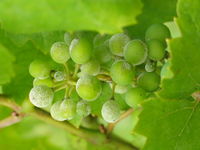Erysiphe necator
| Literature database |
|---|
| 252 articles sorted by: |
| • year (descending) |
| • research topics |
| • countries/regions |
| • host plants |
| • list of antagonists |

Author(s): Phytomedizin DLR Rheinpfalz
Source: Hortipendium
Erysiphe necator Schwein. 1832 - (grapevine powdery mildew)
The fungus has a world-wide distribution in grape growing regions and causes the important vine mildew disease. It is considered to be of North American origin and was first reported from Europe in 1845 where it spread rapidly, infecting millions of hectares of vineyards.
A yield loss of more than 20% has been determined by comparing healthy with infected vines. In addition, the disease results in poor wine quality. In France about 30% of all fungicides are used on grapevines against E. necator and Plasmopara viticola.
The fungus overwinters as ascospores in the cleistothecia of infected leaves or as mycelium/conidia in dormant buds. In spring, it spreads to the newly developing leaves and infects the outer leaf cells. After several weeks, conidia are formed asexually during moist conditions. These disperse by wind and cause new infections. Berries can also become infected. In late summer and autumn, sexual reproduction results in the formation of cleistothecia which persist until the next season. Fungicides, especially sulfur compounds, are commonly used to control the disease. However, resistance has developed against several fungicides.
| Vernacular names | |
|---|---|
| • Deutsch: | Mehltau der Weinrebe |
| • English: | grapevine powdery mildew vine mildew powdery mildew of grapevine |
| • Español: | cenicilla polvorienta de la vid |
| • Français: | blanc de la vigne oïdium de la vigne |
The fungus has an unusual, external mode of infecting the grapevine leaves. Unlike most other plant pathogenic fungi, it does not invade the plant but lives on the leaf surface, obtaining nutrients through specialized haustoria cells. Each haustorium penetrates the cuticle of an epidermal host cell.
Conidia are elliptical in shape and around 30-35 x 20 µm large. Chasmothecia are spherical, about 100 µm in diameter and brown to black. Ascospores are about 20 x 10-15 µm large.
Synonyms:
Oidium tuckeri
Uncinula necator
For a review see Gadoury et al., 2012.
- Other images of Erysiphe necator (Wikimedia Commons and IPM Images - click to enlarge)

